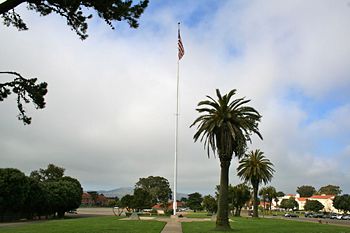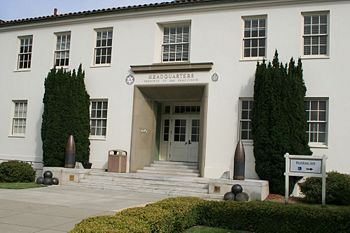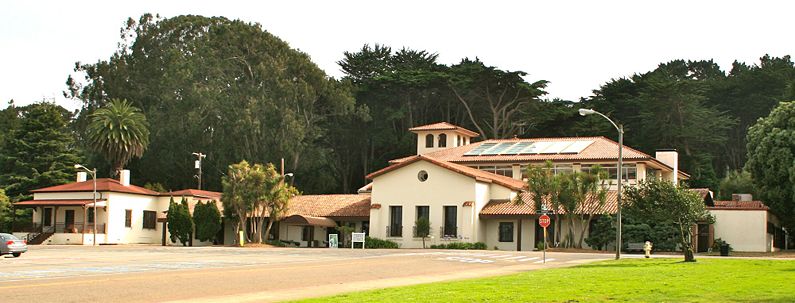Presidio of San Francisco
| More information at Warlike, Wikidata, Wikipedia
Presidio of San Francisco (1776-1995) - First established as a fortification in 1776 by Spanish Captain Juan Bautista de Anza on the northern tip of the San Francisco Peninsula in present day San Francisco County, California. Subsequently occupied by Mexican troops (1822-1846) and then American troops (1846-1995). Turned over by the U.S. Army to the National Park Service in 1995 and transferred to the Presidio Trust in 1996.
Spanish Period (1776-1922)Four Spanish Presidios (Forts) were built by the Spanish Governors of California in what was known as Alta California (Upper California). The four Presidios were the Presidio of San Diego, the Presidio of Santa Barbara, the Presidio of Monterey and the Presidio of San Francisco. Each of the California Presidios was the headquarters of a military district:
Each of the Presidios had a number of missions associated with it in the surrounding military district. The Presidio was responsible for the military protection of the missions and converts but normally had only a small number of troops actually posted at each mission. The majority of the garrison remained in reserve at each presidio. The six missions associated with the Presidio of San Francisco were Mission Santa Cruz, Mission San Jose, Mission Santa Clara de Asis, Mission San Francisco de Asis (Mission Dolores), Mission San Rafael Arcangel and Mission San Francisco Solano. See the California Missions Category for a complete list. 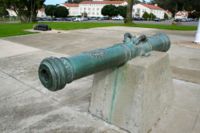 The Presidio of San Francisco was originally named the Presidio de Yerba Buena. The fortification was established on 28 Mar 1776 to protect Spanish interests and claims in the area. The presidio was built as a 600' square compound constructed of adobe brick in the manner of a stockade. Among the first buildings were a church and quarters for the first commandant, Captain Jose Joaquin Moraga. Some of the original commandant's quarters survives today as part of the old Officer's Club, now the NPS Visitor Center. The Spanish troops also completed a coastal fortification at the tip of the San Francisco Peninsula called Castillo de San Joaquin or Fort Blanco. Two of the eight original cannons from that fortification now protect the entrance to the NPS Visitor Center and two more are located on the parade.
Mexican Period (1822-1846)Mexico gained independence from Spain in 1822 and assumed control of Spanish interests in California. The Mexicans garrisoned the presidio until the beginning of the Mexican-American War in 1846. They were removed in July 1846 by a detachment of U.S. Marines. The treaty of Guadalupe Hidalgo was signed on 2 Feb 1848 to end the war and cede California to the United States. The Presidio of San Francisco became a U.S. Army post. American Establishment (1848-1861)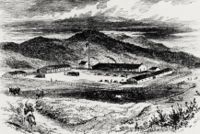 As the United States established control over California, Oregon and Washington, the strategic importance of the Presidio became evident and the post was improved and expanded. The gold rush in 1849 made the post even more important and the decision to place the only Third System coastal fort on the west coast at San Francisco was taken. The old Spanish coastal fort was razed and the new fort was constructed on the excavated site of the old fortification. Colonel Mansfield's 1854 inspection of the Presidio found it with only only one officer and 55 privates present for duty. He also found the enlisted quarters miserable and the officer quarters not much better. Desertion to the gold fields was common and prices were so high that it was difficult for even the officers to survive on military pay. Nearly all the officers sent their families back east because they could not afford to feed them in the San Francisco Area.
U.S. Civil War (1861-1865)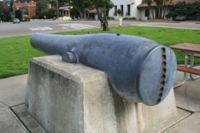 At the beginning of the U.S. Civil War many regular U.S. troops left San Francisco either to join the Confederacy or to fight for the Union on the east coast. Only 500 troops remained in April of 1861 and only 115 at the Presidio. They were eventually replaced with California Volunteers (Union) who garrisoned many of the western Forts. The new Fort point was quickly completed and garrisoned with California Volunteers. Camp SumnerCamp Sumner (2) (1861-1865) was established just outside the Presidio to keep track of Secessionist activity in San Francisco. The Indian Wars of the 1870s and 1880s saw Presidio soldiers in action against the Modoc Indians in the lava beds of northern California and against Apache Indians in the Southwest.
Endicott Period (1890-1910)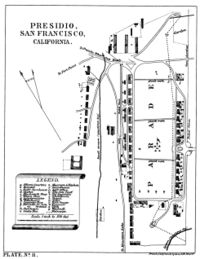 In 1890 the Presidio began to provide detachments to three new national parks to protect them each summer from tourists, poachers, illegal grazing and logging. Detachment were set up at Yosemite, Sequoia and Kings Canyon. These detachments constructed facilities and roads that opened up these national treasures. The detachments ended in 1916 when the forerunner of the national park service took over operation of the parks.
Spanish American War (1898-1898)During the Spanish-American War and the later Philippine conflicts, large tent camps were placed in the Main Post area to accommodate troops headed for the Philippines. The forerunner to Letterman General Hospital treated the sick and wounded returning from the Philippine conflicts. Presidio Spanish American War Camps:
The Presidio provided tent camps for refugees from the 1906 San Francisco earthquake and helped restore law and order. Four tent camps were set up on the Presidio complete with sanitary facilities and cooking facilities for the civilian refugees.
World War I (1917-1918)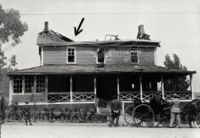 General "Black Jack" Pershing led a punitive expedition from the Presidio against the Mexican bandit Pancho Villa along the Mexican border in 1914. While he was away, General Pershing's wife and daughters perished when his Presidio quarters caught fire. A memorial and a post flag pole mark the spot where the house stood. The memorial plaque contains an image of his quarters. General Pershing and his troops returned to the Presidio in May 1917 and he went on to lead the American Expeditionary forces in Europe during World War I. The Presidio again served as a staging area for troops headed for the conflict in France. Temporary cantonments were built to house the troops. The North cantonment contained enough single story frame and tarpaper barracks to house 6,000 troops and tent camps handled any overflow. An officer training school was established in 1917 on the Presidio and the first class of 2,500 candidates produced only 1,000 candidates recommended for reserve commissions. Letterman Hospital hospital was again used to treat the returning sick and wounded. The hospital treated 18,700 during the war and another 12,400 in the year after the war. A large set of wards and barracks were built to accommodate the huge number of patients.
World War II (1941-1945)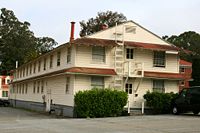 The Presidio expanded again in 1941 as the peace-time draft began before the start of the war. Temporary barracks were again built to accommodate the new draftees. After the war started the Presidio processed troops headed for the Pacific theater of war. Letterman Hospital received the sick and wounded returning from the Pacific theater, registering a peak load of 76,000 patients in 1945.
Cold War (1946-1994)The Presidio was the headquarters for the Golden Gate Nike Missile defense system and also contained launch site SF-89L (1954-1974).
Current StatusPart of the Golden Gate Recreation Area (GGNRA) administered by the National Park Service. A National Historic Site since 16 Oct 1970.
Sources:
Visited: 10 Oct 2015, 22-27 Aug 2009 | ||||||||||||||||||||||||||||||||||||||||||||||||||||||||||||||||||||
- Visited
- All
- California All
- California Forts
- California San Francisco County
- Presidio of San Francisco
- California Missions
- California Presidios
- Spanish Colonial Forts
- World War I Forts
- World War II Forts
- U.S. Civil War Forts
- National Recreation Area
- Starter Page
- Preserved
- Must See
- 2009 Northern California Trip
- 2013 Research Trip
- 2016 Research Trip
